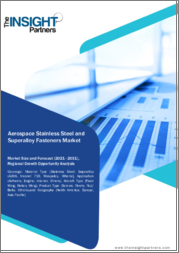
|
시장보고서
상품코드
1623841
항공우주 및 방위 재료 시장 규모, 점유율, 성장 분석, 재료별, 부품별, 용도별, 지역별 - 산업 예측(2025-2032년)Aerospace and Defense Materials Market Size, Share, Growth Analysis, By Material (Aluminum, Titanium), By Parts (Aero Structure, Components), By Application, By Region - Industry Forecast 2025-2032 |
||||||
항공우주 및 방위 재료 시장 규모는 2023년 437억 7,000만 달러로 평가되었습니다. 2024년 468억 7,000만 달러에서 2032년에는 773억 1,000만 달러로 성장할 것으로 예상되며, 예측 기간(2025-2032년) 동안 7.08%의 연평균 복합 성장률(CAGR)을 나타낼 전망입니다.
항공우주 및 방위 재료 시장은 국방 예산 증가, 민간 항공기 수요 증가, 기술 발전으로 인해 강력한 성장세를 보이고 있습니다. 지정학적 긴장은 각국의 군사력 현대화를 촉진하여 국방비 증가와 시장 기회 확대를 촉진하고 있습니다. 또한, 규제 강화와 환경 인식이 높아지면서 지속 가능하고 친환경적인 소재로의 전환이 두드러지게 나타나고 있습니다. 제조업체들은 이산화탄소 배출을 최소화하기 위해 바이오 소재, 재활용 가능한 복합재, 경량 합금을 생산 공정에 통합하는 경향이 증가하고 있습니다. 이러한 전환은 생태학적 문제를 해결할 뿐만 아니라, 특히 연료 효율과 유지보수 측면에서 비용 절감의 이점을 가져다줍니다. 그 결과, 시장은 성능과 지속가능성 두 가지 측면에 초점을 맞추어 진화하고 있습니다.
목차
서론
- 조사 목적
- 조사 범위
- 정의
조사 방법
- 정보 조달
- 2차 데이터와 1차 데이터 방법
- 시장 규모 예측
- 시장 전제조건과 제한
주요 요약
- 세계 시장 전망
- 공급과 수요 동향 분석
- 부문별 기회 분석
시장 역학과 전망
- 시장 개요
- 시장 규모
- 시장 역학
- 성장 촉진요인과 기회
- 성장 억제요인과 과제
- Porter의 Five Forces 분석
주요 시장 인사이트
- 중요 성공 요인
- 경쟁 정도
- 주요 투자 기회
- 시장 생태계
- 시장의 매력 지수(2024년)
- PESTEL 분석
- 거시경제 지표
- 밸류체인 분석
- 가격 분석
항공우주 및 방위 재료 시장 규모 : 재료별
- 시장 개요
- 알루미늄
- 티타늄
- 복합재료
- 초합금
- 강철
- 플라스틱
- 기타
항공우주 및 방위 재료 시장 규모 : 부품별
- 시장 개요
- 에어로 구조
- 컴포넌트
- 캐빈 인테리어
- 추진 시스템
- 기기 시스템 지원
- 위성
- 건설 및 단열 부품
항공우주 및 방위 재료 시장 규모 : 용도별
- 시장 개요
- 상업용
- 비즈니스 및 일반 항공
- 군용
- 기타
항공우주 및 방위 재료 시장 규모
- 북미
- 미국
- 캐나다
- 유럽
- 독일
- 스페인
- 프랑스
- 영국
- 이탈리아
- 기타 유럽
- 아시아태평양
- 중국
- 인도
- 일본
- 한국
- 기타 아시아태평양
- 라틴아메리카
- 브라질
- 기타 라틴아메리카
- 중동 및 아프리카
- GCC 국가
- 남아프리카공화국
- 기타 중동 및 아프리카
경쟁 정보
- 주요 5개사 비교
- 주요 기업의 시장 포지셔닝(2024년)
- 주요 시장 기업이 채택한 전략
- 시장 최근 동향
- 기업의 시장 점유율 분석(2024년)
- 주요 기업 개요
- 기업 개요
- 제품 포트폴리오 분석
- 부문별 점유율 분석
- 매출 전년대비 비교(2022-2024년)
주요 기업 개요
- Toray Industries, Inc.(Japan)
- Solvay S.A.(Belgium)
- DuPont de Nemours, Inc.(USA)
- Alcoa Corporation(USA)
- Teijin Limited(Japan)
- Allegheny Technologies Incorporated(USA)
- Constellium SE(France)
- Kobe Steel, Ltd.(Japan)
- AMG N.V.(Netherlands)
- NOVELIS(USA)
- Hexcel Corporation(USA)
- VSMPO-AVISMA Corporation(Russia)
- Mitsubishi Chemical Holdings Corporation(Japan)
- SGL Carbon(Germany)
- Hyosung Advanced Materials(South Korea)
- Arconic Corporation(USA)
- thyssenkrupp Aerospace Germany GmbH(Germany)
- Carpenter Technology Corporation(USA)
- Haynes International, Inc.(USA)
- Materion Corporation(USA)
결론과 추천 사항
LSH 25.01.20Aerospace and Defense Materials Market size was valued at USD 43.77 Billion in 2023 and is poised to grow from USD 46.87 Billion in 2024 to USD 77.31 Billion by 2032, growing at a CAGR of 7.08% during the forecast period (2025-2032).
The aerospace and defense materials market is experiencing robust growth, propelled by escalating defense budgets, heightened demand for commercial aircraft, and significant technological advancements. Geopolitical tensions are prompting nations to modernize military capabilities, driving increased defense spending and expanding market opportunities. Additionally, there's a notable shift towards sustainable and environmentally friendly materials amid stricter regulations and rising environmental awareness. Manufacturers are increasingly integrating bio-based materials, recyclable composites, and lightweight alloys into their production processes to minimize carbon footprints. This transition not only addresses ecological concerns but also yields cost-saving advantages, particularly in fuel efficiency and maintenance. As a result, the market is set to evolve with a dual focus on performance and sustainability.
Top-down and bottom-up approaches were used to estimate and validate the size of the Aerospace And Defense Materials market and to estimate the size of various other dependent submarkets. The research methodology used to estimate the market size includes the following details: The key players in the market were identified through secondary research, and their market shares in the respective regions were determined through primary and secondary research. This entire procedure includes the study of the annual and financial reports of the top market players and extensive interviews for key insights from industry leaders such as CEOs, VPs, directors, and marketing executives. All percentage shares split, and breakdowns were determined using secondary sources and verified through Primary sources. All possible parameters that affect the markets covered in this research study have been accounted for, viewed in extensive detail, verified through primary research, and analyzed to get the final quantitative and qualitative data.
Aerospace And Defense Materials Market Segmental Analysis
Global Aerospace and Defense Materials Market is segmented by material, parts, application and region. Based on material, the market is segmented into aluminum, titanium, composites, superalloys, steel, plastics and others. Based on parts, the market is segmented into aero structure, components, cabin interiors, propulsion system, equipment, system, & support, satellites and construction & insulation components. Based on application, the market is segmented into commercial, business & general aviation, military and others. Based on region, the market is segmented into North America, Europe, Asia Pacific, Latin America and Middle East & Africa.
Driver of the Aerospace And Defense Materials Market
The Aerospace and Defense Materials market is significantly influenced by the surge in global air passenger traffic, which is propelling the demand for new aircraft. This heightened demand emphasizes the necessity for advanced aerospace materials that contribute to fuel efficiency, lower emissions, and enhanced overall performance. Consequently, there is a growing trend towards utilizing lightweight materials such as composites in aircraft production. This shift not only addresses the pressing need for improved aircraft capabilities but also aligns with environmental considerations, making the development and deployment of innovative materials crucial in meeting the evolving requirements of the aerospace sector.
Restraints in the Aerospace And Defense Materials Market
The aerospace and defense materials market encounters several restraints primarily due to supply chain challenges stemming from its intricate structure, which involves multiple suppliers and rigorous quality control standards. Sourcing and managing dependable, high-quality materials for specialized applications prove to be quite difficult. Any disruptions within the supply chain can lead to considerable delays in production schedules and subsequently elevate costs. Therefore, ensuring a strong and efficient supply chain is essential for the overall success and competitiveness of the industry, as it influences both operational efficiency and the ability to meet customer demands in a timely manner.
Market Trends of the Aerospace And Defense Materials Market
The Aerospace and Defense Materials market is experiencing a significant trend towards the adoption of advanced composite materials, driven by their superior strength-to-weight ratios, corrosion resistance, and exceptional durability. These composites, including carbon fiber, fiberglass, and aramid fiber, are increasingly utilized in aircraft structures, resulting in substantial weight reductions that enhance fuel efficiency and overall performance. As manufacturers seek to meet stringent environmental regulations and improve operational efficiencies, the integration of these advanced materials is becoming imperative. This shift not only optimizes the design and functionality of aerospace vehicles but also supports the ongoing innovation and competitiveness within the industry.
Table of Contents
Introduction
- Objectives of the Study
- Scope of the Report
- Definitions
Research Methodology
- Information Procurement
- Secondary & Primary Data Methods
- Market Size Estimation
- Market Assumptions & Limitations
Executive Summary
- Global Market Outlook
- Supply & Demand Trend Analysis
- Segmental Opportunity Analysis
Market Dynamics & Outlook
- Market Overview
- Market Size
- Market Dynamics
- Drivers & Opportunities
- Restraints & Challenges
- Porters Analysis
- Competitive rivalry
- Threat of substitute
- Bargaining power of buyers
- Threat of new entrants
- Bargaining power of suppliers
Key Market Insights
- Key Success Factors
- Degree of Competition
- Top Investment Pockets
- Market Ecosystem
- Market Attractiveness Index, 2024
- PESTEL Analysis
- Macro-Economic Indicators
- Value Chain Analysis
- Pricing Analysis
Global Aerospace and Defense Materials Market Size by Material & CAGR (2025-2032)
- Market Overview
- Aluminum
- Titanium
- Composites
- Superalloys
- Steel
- Plastics
- Others
Global Aerospace and Defense Materials Market Size by Parts & CAGR (2025-2032)
- Market Overview
- Aero Structure
- Components
- Cabin Interiors
- Propulsion System
- Equipment, System, & Support
- Satellites
- Construction & Insulation Components
Global Aerospace and Defense Materials Market Size by Application & CAGR (2025-2032)
- Market Overview
- Commercial
- Business & General Aviation
- Military
- Others
Global Aerospace and Defense Materials Market Size & CAGR (2025-2032)
- North America (Material, Parts, Application)
- US
- Canada
- Europe (Material, Parts, Application)
- Germany
- Spain
- France
- UK
- Italy
- Rest of Europe
- Asia Pacific (Material, Parts, Application)
- China
- India
- Japan
- South Korea
- Rest of Asia-Pacific
- Latin America (Material, Parts, Application)
- Brazil
- Rest of Latin America
- Middle East & Africa (Material, Parts, Application)
- GCC Countries
- South Africa
- Rest of Middle East & Africa
Competitive Intelligence
- Top 5 Player Comparison
- Market Positioning of Key Players, 2024
- Strategies Adopted by Key Market Players
- Recent Developments in the Market
- Company Market Share Analysis, 2024
- Company Profiles of All Key Players
- Company Details
- Product Portfolio Analysis
- Company's Segmental Share Analysis
- Revenue Y-O-Y Comparison (2022-2024)
Key Company Profiles
- Toray Industries, Inc. (Japan)
- Company Overview
- Business Segment Overview
- Financial Updates
- Key Developments
- Solvay S.A. (Belgium)
- Company Overview
- Business Segment Overview
- Financial Updates
- Key Developments
- DuPont de Nemours, Inc. (USA)
- Company Overview
- Business Segment Overview
- Financial Updates
- Key Developments
- Alcoa Corporation (USA)
- Company Overview
- Business Segment Overview
- Financial Updates
- Key Developments
- Teijin Limited (Japan)
- Company Overview
- Business Segment Overview
- Financial Updates
- Key Developments
- Allegheny Technologies Incorporated (USA)
- Company Overview
- Business Segment Overview
- Financial Updates
- Key Developments
- Constellium SE (France)
- Company Overview
- Business Segment Overview
- Financial Updates
- Key Developments
- Kobe Steel, Ltd. (Japan)
- Company Overview
- Business Segment Overview
- Financial Updates
- Key Developments
- AMG N.V. (Netherlands)
- Company Overview
- Business Segment Overview
- Financial Updates
- Key Developments
- NOVELIS (USA)
- Company Overview
- Business Segment Overview
- Financial Updates
- Key Developments
- Hexcel Corporation (USA)
- Company Overview
- Business Segment Overview
- Financial Updates
- Key Developments
- VSMPO-AVISMA Corporation (Russia)
- Company Overview
- Business Segment Overview
- Financial Updates
- Key Developments
- Mitsubishi Chemical Holdings Corporation (Japan)
- Company Overview
- Business Segment Overview
- Financial Updates
- Key Developments
- SGL Carbon (Germany)
- Company Overview
- Business Segment Overview
- Financial Updates
- Key Developments
- Hyosung Advanced Materials (South Korea)
- Company Overview
- Business Segment Overview
- Financial Updates
- Key Developments
- Arconic Corporation (USA)
- Company Overview
- Business Segment Overview
- Financial Updates
- Key Developments
- thyssenkrupp Aerospace Germany GmbH (Germany)
- Company Overview
- Business Segment Overview
- Financial Updates
- Key Developments
- Carpenter Technology Corporation (USA)
- Company Overview
- Business Segment Overview
- Financial Updates
- Key Developments
- Haynes International, Inc. (USA)
- Company Overview
- Business Segment Overview
- Financial Updates
- Key Developments
- Materion Corporation (USA)
- Company Overview
- Business Segment Overview
- Financial Updates
- Key Developments



















